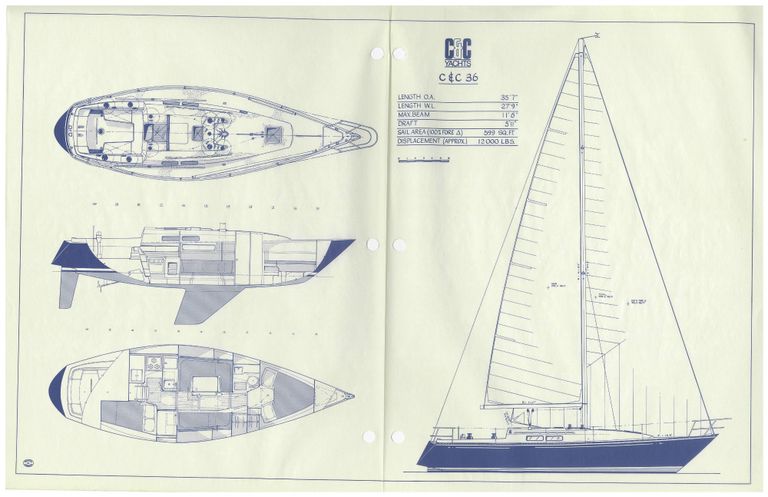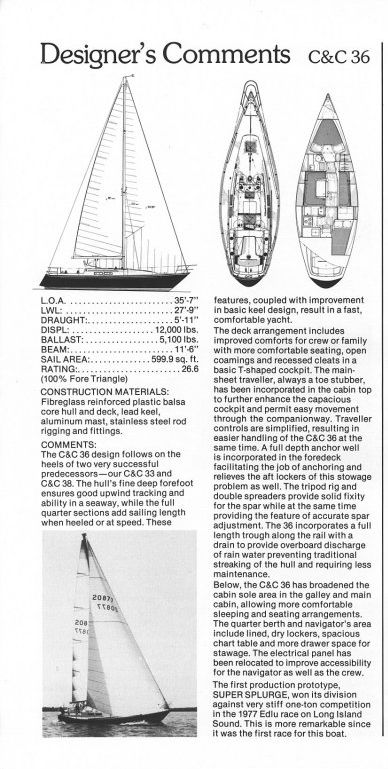

C&C 36
LOA: 35' 8” LWL: 27' 9"
Yacht Names
Selah,
Chamamé - Reflection - Cirrus
DWG #
76-6
2008.0012.0026 (1-4),
2008.0012.0096 (1-4),
2008.0012.0094 (1),
2008.0012.0084 (1-3),
2008.0012.0132 (1),
2008.0012.0159 (1-3),
2008.0012.0093 (1)
2001.0066.0172.0001,
2001.0066.0172.0002,
2001.0066.0172.0003
Designer / Draughtsman
C&C Design Group,
"Killing, Steve : SK",
"Mazza, Rob : RM",
"Kelly, Bruce",
Project Manager
"Mazza, Rob : RM"
Year of Design
1976
Builder
C&C Yachts Limited
Other People
"Rutherford, Tim"
Notes
Perry Design Review:
C&C 36 C&C continues its production of beautifully styled boats.
By Bob Perry
August 25, 2000
This review gives us the opportunity to compare C&C's latest 36-foot offering, which is actually a progression of the C&C 34+, with the 1975 vintage C&C 36. Both boats share good looks. The old C&C 36 shows a deck that is typical of vintage C&C designs, with a shapely trunk fairing into a rounded bullet shape as it goes forward. The new 36 shows an exquisitely sculpted trunk, far more dramatic than the older 36, but with the same basic character. The hulls share some numbers in addition to similar LOAs.
Both boats weigh 12,000 pounds and have beams within an inch of each other at 11 feet, 6 inches and 11 feet, 7 inches. The biggest difference in basic dimensions is at the DWL. The old 36 had a DWL of 27 feet, 9 inches, and the new 36 has a DWL of 30 feet for an additional 2 feet, 3 inches. This extra DWL brings the D/L down from 251 to 198.4. The plan view shows that while the beams are similar, the distribution of beam is distinctly different. The old 36 was still trying to keep its measured IOR length down with what we came to call "pinched ends." The new 36, on the other hand, has an extremely broad stern.
Looking at the rest of the hull shape, I can see a strange little kick to the counter profile aft. Generally, you like to keep the run and counter as flat as possible. Both hulls show small skegs in front of the rudders, but the newer 36 has a vertical rudder stock and a rudder that cuts off at the DWL and doesn't meet the counter. The keel of the new 36 shows that we have come to fins with bulbs from the days of the old 36 when keels were bladelike fins. People want horsepower and you need stability to carry a big rig. The best way to increase stability is to put some type of bulb on the keel. Interestingly, the older fin-keeled 36 had 400 pounds more ballast than the newer fin-keeled model. There is also a wing keel, shoal draft model with 4 feet, 11 inches of draft and 5,225 pounds of ballast. Going below we see dramatic differences between the two boats. The arrangement plan differences are as marked, if not more marked, than are the hull shape differences. The old 36 is very typical of the layouts of the day, very boxlike with lots of 90-degree angles. The quarter berth of the old 36 is a double in the new 36, hinting at things to come. The new 36 has a layout developed from the years of influence the European designs have had on us, such as the queen-sized quarter berth in its own separate stateroom. This puts pressure on the galley, so the new 36 has less counterspace. The head on the new boat is aft and includes a shower stall. The nav station is coupled to the starboard settee. Forward V-berths are history, and the new 36 has a large double berth forward. Progress is wonderful. I would also like to know how much the layout had to do with the width of the stern on the newer design. I'm partial to the older layouts, but that's just me trying to hold on to the things I loved about boats as a boy. Interiors are so subjective.
...
https://www.boatingworld.com/boattests/c-c-36/
Number Built
270 ish
Brochure
https://boatbrochure.com/products/c-c-36-brochure?_pos=1&_sid=15e34d207&_ss=r
Web Link
https://sailboatdata.com/sailboat/cc-36-1
Gilbert Moulds
C&C 36, C&C 36, C&C 36D deck